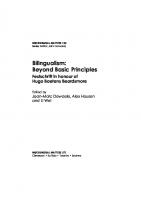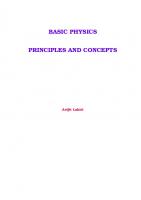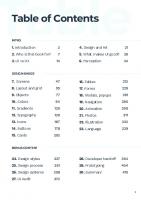Basic Principles of Design [3] 0442249799, 9780442249793
143 92
English Pages 104 [108] Year 1977
Recommend Papers
File loading please wait...
Citation preview
The Foundation Program at we School of Design Basel, Switzerland
Basic Principles of Design
Van Nostrand/ Reinhold
Volume 3
Material Studies
Textile Design Color 2
School of Design Basel, Switzerland Foundation Program
VAN NOSTRAND NEW
YORK
CINCINNATI
REINHOLD TORONTO
COMPANY
LONDON
MELBOURNE
The Foundation Program at the School of Design Basel, Switzerland
Manfred Maier
Basic Principles of Design
Volume
Object Drawing Object and Museum Drawing Nature Drawing
Volume
Memory Drawing Technical Drawing and Perspective Lettering
2
Volume
Material Studies
Textile Design Color 2
Volume 4
Color 1 Graphic Exercises Dimensional Design
This book was originally published in Switzerland under the title Elementare Entwurfs- und Gestaltungsprozesse. Die Grundkurse an der Kunstgewerbeschule Basel, Schweiz. by Verlag Paul Haupt Berne Copyright © 1977 by Paul Haupt Berne Conception and Design: Manfred Maier Photography:
Published in 1977 by Van Nostrand Reinhold Company A Division of Litton Educational Publishing, Inc. 450 West 33rd Street New York, NY 10001, U.S.A.
Max Mathys
Van Nostrand Reinhold Australia Pty. Ltd. 17 Queen Street
(Dimensional Design/Ruth Geshekter) Cover Design: Wolfgang Weingart English version: Joseph Finocchiaro William Longhauser Janet Longhauser
Van Nostrand
Reinhold
Limited
1410 Birchmount Road Scarborough, Ontario M1P 2E7, Canada
Mitcham, Victoria 3132, Australia
Van Nostrand Reinhold Company Ltd. Molly Millars Lane Wokingham, Berkshire, England 16 MS 14SIS 25 ti ONO Ss 7i6nb 74535201
Library of Congress Catalog Card Number 77-3493
ISBN 0-442-24977-2 (v. 1)
Library of Congress Cataloging in Publication Data
ISBN 0-442-24978-0 (v. 2)
ISBN 0-442-24979-9 (v.3)
ISBN 0-442-24980-2 (v. 4) All rights reserved. No part of this work covered by the copyright hereon may be reproduced or used in any form or by any means—graphic,
electronic, or mechanical, including photocopying, recording, taping, or information storage and retrieval systems—without written permission
of the publisher.
Printed in Switzerland
Composition: Schuler AG, Biel Films: Aberegg-Steiner AG, Bern Offset-Printing: Roto-Sadag SA, Geneva Bookbinding: Roger Veihl, Geneva
Maier, Manfred Basic principles of design. Translation of Elementare Entwurfs- und Gestaltungsprozesse. Die Grundkurse an der Kunstgewerbeschule Basel, Schweiz. CONTENTS: v.1. Object drawing, object and museum drawing, nature drawing. — v.2. Memory drawing, technical drawing and perspective, lettering. — v.3. Material studies, textile design, color 2. — v.4. Color 1, graphic exercises, dimensional design. 1. Design—Study and teaching. I. Title NK1170.M3413 745.4’07 77-3493 ISBN 0-442-24977-2 (v. 1) ISBN 0-442-24978-0 (v. 2) ISBN 0-442-24979-9 (v.3) ISBN 0-442-24980-2 (v.4)
General
Introduction
Kurt Hauert, Head of the Foundation Program
The Foundation Program at the School of Design in Basel, Switzerland is a fundamental education in art and design. It offers a number of interrelated, equally important courses. Subjects include drawing, color, three-dimensional studies, materials and tools, and exercises in form, aesthetics, and concepts, all of which are designed to promote optical and tactical sensitivity, formal perception, manual dexterity, and a clear understanding of creative processes and to Clarify the students’ individual talents. The program enables them to choose future professional training in graphic design, photography, typography, display design, goldsmithery, pottery, fine art, sculpture, and other related fields. To be admitted into the program, students must be at least 15 years old, pass an entrance examination, and attend all the classes. The one-year program includes 42 classroom hours per week. All
classes are conducted at the school and are limited to a maximum of 24 students. Most of the faculty members are also professionals in their
field, certified specialists who are active in visual, creative areas. Throughout the entire program, the teachers are available for individual or group consultation, which ensures that every student has an equal opportunity for a successful training. The teaching-learning process varies with each course. It can progress in several directions: linear, from simple to difficult principles; punctual, a collection of experiences derived from individual assignments; or complex, an analysis of variation sequences as an insight into the creative process.
The current standards of the program are outlined in this series, and the working procedure is explained clearly and understandably in chronological sequence. In order to clarify the interrelationships among the courses, they are categorized according to
the teaching-learning process involved. The entire visual-creative program is presented in four volumes, each of which is a complete unit in itself and provides an introduction, course descriptions, and detailed illustrations. The Foundation Program is based on an objective, developmental educational system over the past thirty years. It disregards
fashionable vogues but allows enough freedom to integrate necessary innovations. It offers a model for all teachers, students, and administrators who are interested in a critical, investigatory approach.
In conclusion special thanks are expressed to those who devoted their time and energy to the realization of this work.
Table of Contents
Volume 1
Contributors: Object Drawing Sommer H. P./Stettler P. Object and Museum Drawing Sommer
Nature Studies Sommer H. P./ Stettler P.
fe>)
42
H. P./Pola P.
74
NOW PMee
HIE AI
pagar)
Volume2
Contributors:
Memory Drawing His A. Technical Drawing and Perspective Trameér J. Lettering Girtler A.
Volume4
Volume3
Contributors:
Contributors:
11
Material Studies
11
Hutter J.
44
Textile Design Hernandez-Moor
76
42 L. / Kern U.
Color 2 Gautschi
74 R. / Pola P.
Color 1 Zwimpfer M. Graphic Exercises Maier M. Dimensional Design Grossenbacher
11 42 74
M.
“NI
Schedule Summer
Semester
1975
Foundation Program Hours
Graphic Exercises
4
Color 2 Color 1 Object Drawing Nature Drawing Lettering Memory Drawing Textile Design Dimensional Design Literature, Language Physical Education Information Technical Drawing and Perspective
3 3 4 2 2 3 2 4 2 2 2 3
Material Study
3
Object and Museum Drawing
3 42
Number of faculty in the Foundation Program Number of students in the Foundation Program in six parallel classes
26 130 ca.
Directorship:
Faculty of the Foundation Program
until 1970 Emil Ruder since 1971 Niklaus Morgenthaler Head of the Foundation Program: since 1971 Kurt Hauert
Beck, A. Biesele, I. Bollin, M. Burgin, G. Burla, J. Eya, L. Gautschi, R. Grossenbacher, M. Gurtler, A. His, A.
Economics Graphic Design Sculpture Decoration Sculpture Architecture Painting Sculpture Letter Design Painting
Hutter, J.
Keller, T. Kern, R. Kern, U.
Drawing
Sulzbachner,
Klotz, L. Maier, M. Mengelt, C. Mengelt, M. Pola, P. Schafer, E. Sommer, H. P. Thomann, M. Trameér, J. Von Tomei, J. Zwimpfer, G. Zwimpfer, M.
Painting Graphic Design Graphic Design Graphic Design Painting Drawing Graphic Design Language Painting Graphic Design Graphic Design Graphic Design
Vollé, R. Vieira, M. Weidmann, H.
@
Bernoulli, L. Buhler, G. Ganahl, K. Gruber, A. Hartmann, H. Hauert, K. Hernandez-Moor, L. Keller, J. Lienhard, E. Messerli, E.
Architecture Drawing Press-editing Sculpture Drawing Drawing Textile Design Drawing Sculpture Painting
1972-73 1968-69 1966-67 1969-70 1968-69 1969-70 1972-73 1974-75 1972-73 1972-73
Painting
Ryser, F.
Painting
1973-74
Painting Painting
Stettler, G. Stettler, P.
Painting Painting
1967-68 1974-75
Painting
1968-69
Architecture Sculpture Painting
1968-69 1968-69 1966-67
M.
Volume
Material Studies
3
Textile Design Color 2
Volume3
Introduction
The primary feeling for material, for its beauty and possibilities of expression, is largely lost with technological and industrial specialization. We daily encounter new materials and larger quantities, which demand more than abstract, intellectual, and commercial knowledge and behavior. An involvement with materials goes back to the teachers of the Bauhaus and the development of fine arts during the last 50 years. The goals of this volume are a familiarity with the interrelation of material, technique, and form and with tactile and optical qualities, a differentiation of tactile feeling, observation, manual experimentation, spontaneous invention and discovery, and
an understanding of different techniques and raw materials. Single results are achieved in many elementary exercises with minimal material and technical investment. The individual exercises are not arranged systematically: corresponding to the subjective, spontaneous working method, the evaluation of criteria is redefined in each exercise by comparing results. Experience with the materials and with their characteristics is derived from creative involvement with optical and tactile sensitivity and with the critical consciousness. Personal, intuitive differentiations corresponding to individual abilities result through experimentation and stimulate new goals for faculty as well as students. The goals of the teaching and learning process are clarified through cooperative involvement with the more structured courses described in volume 4.
Material Studies
In today’s technical civilization a feeling for the characteristics and possibilities of materials is suppressed. Tactual sensitivity and fantasy are the goals of this course: students are stimulated by manipulating and working the materials as form and expression. Unbiased experimentation, spontaneous perception of chance occurrences and their consequent development produce new, surprising possibilities that are unpredictable intellectually. In elementary exercises students investigate the changing appearances of materials in different environments, the manipulation of the surface, the kind and incidence of light, and
compositional rules. The relationships between the character, form, and color of materials pre-
sent limitations in the definition of expressive possibilities. Ordinary raw materials and disposables are worked with simple tools; awareness of the media is developed through exercises in alteration, texture, and touch (with disposable
materials); discovery (with wood and synthetics); connecting (with many materials); and themes (transparency and fluidity). Unusual elementary working techniques such as tearing, scratching, breaking, burning, folding, slitting, scoring, hammering, cutting, gluing, and fastening are explored and used. Manual-technical, formal, and compositional interrelations are compared and evaluated through single exercises and themes with as many variations as possible. Thus, new stimulation and various qualities of expression are produced. The students’ valuation possibilities consist in exchanging experiences, comparing working results, and working together. Technical ability, critical consciousness,
and manual
apti-
tude develop with the number and complexity of the exercises.
11
Paper is used everyday in a conventional manner as wrapping or packing material and for drawing, writing, and printing. The natural surface and structure are transformed and disfigured through unconventional mechanical activities. Experience with the material characteristics of paper through physical contact with the resulting textures develops tactile sensitivity. A new optical relationship to the raw material through its transformation
is produced
iM
Pal i
in technical, con-
sciously unpretentious exercises with simple tools.
4 a Ef Z z
cy Tnreeurermrtertrrt Prrererernrt
: Lee apeet es wehessyes re
crete ie prireritirreretertrnnce
ie NARASAS RSS teat SRGawe SN ASaaS atte ASNEARER SS SAAS ae SAMARAS
IB orth A
i)
SSS AAA SR SRRSS ASSE SSS —
A sheet of paper is divided into nine sections, each of which is gradually differentiated in texture with simple tools: knives, nails, and needles. The number of sections can be expanded for other discovered possibilities. The illustrations on the following two pages show details and single studies of such work.
The photographs here and on the following two pages document the methods and tools used to create textures.
12
,
A textural relief is produced by lightly tapping on a wood chisel and its even shifting.
Indented round forms are produced by pressing or lightly tapping on a metal punch.
}
z athe (neDUISNIKANN
} poo
eee RESO
Nig
y f
ay
&yee ERR
}
}
eh
H
)
45
Lag
\
a vena
Ea
Re
ee
& Me Hee Eetr
Pie: hy Nida ti
2. At: C.eseeee
ae ; aware iA sue Met eenad® ook cet tiat
f
t
PALMA
eco be
Os
RaW vawnees
\ i
ig
RA
vi Ve det cr tryed
OE
I2
Bee
aes
ee Wa Sm
fe
Kak Hg
Ee ;
ewe ew ss
PONS OEE 2%
eX
© NE DE
ERE
fee
Fs
YEMSe 7
#3 SR OW FRR ne WWE BEY We &brani KK i CM DOE SEO CEE ws x
hao % (eae
r a
KEL Sed N=
Deke:
PRONE MAAN POHAGRNER KK
LS
ee
Xe owe
MRK
= Ny ‘ PERS Pe ERY @&e DNNINK E ERR TOR SRR CR ON ASOD SY
aa
EA
‘ ay ry
Og
ewe
WER
Pee COCCU UL REE
val
tO
SatsVVY
ENS WAN
Vee OLR % A: e “
Wake AAAI y
Hsin
EI
TS WEITER KE UE RYT
WANA HN
RAY SHANE ORE RY
2
"
OREN:
SS MARRS EEK SAN aaa Ce ‘
)
om Oe Nw
NENA RUN NSMERSIN MBE GG HENCEOP RROe VES 4 ae RSERS ENE ee " SKS we Soe & NANE SENS tS Kw AO een Pe yaks Wik VICES 4 wer me ANE ARS ACERS MONE EENG \ iybe She SEN BATE Le EN GE WE WEEE Ce See § KEE Wer ESE RRR E CAN WERE SS ici ci
® ek Yarns
i
wor ee
i Ropu KRESS REY NR EEO CoE N MACS wey MS it SEAS % Vaca RE Wee SEAL ork RA NY NK SE NK WORN & REE ye
WE
,
SoM RE ne ee Dt eG we Ge
eae RET GE MRERENEN
ER
f
RR
Pe ies WN WESS WE SERR S OBOE ENWORK WEY ROMER . NAG A ROY mA SERS
aiNEE,
u \
3
ORR
pete NENe ROE SEW CeO RUE ~S Ais SYhres WER UNION RE Se wSY RMAC A Waka RS RES ONE: ERE SENN RN ” ES MEN
PENRO E,VERSE
} 5
NRANUR BNE
RAN
x >
g
> e
ae
.
i
Nc :
Seagate aad
—%
oon
From top to bottom: The head of a nail is slanted and hammered with different intensities against the paper.
The imprints from a nail head tapped against the paper on soft cardboard produces a raised surface on the opposite side.
The surface of the paper is scratched or lightly cut with a dull knife held at a slight angle from the side.
A spatula or wood chisel is used rhythmically to create hammered depressions at regular intervals.
Finely scored surfaces are achieved with the point of the nail, needles, the back of the knife blade, or similar tools.
Linear reliefs are produced by scoring the back side of the paper on a soft support.
The surface of the paper is slit or cut with a knife held at a slight angle.
Various textures are discovered by scratching the paper with knives held in different positions.
Small triangular shapes with a relieflike grid are formed by cutting and folding back the resulting elements with a knife.
13
LSS pe pee
Sse _— — ee i See a —ee ee: eS eS ees a aca aa aR —— — _— —i —— ~_—— oe oo —— eee Sa a, ooh TSaaa.
ee
——
— fr
a = —
~
SR |
oS
SSS
Ss
—ae
— =
——
ee
ey
= — = a ee,
RE
SS
SS
— a
ee em
aa
—o
mn
RS,
ees
d
7 =pat _— > — —_——
— _
|SU
eet
a
-
a au
mmm aa
a
SS 7
Ege
ee
a
Sr = —_— — -— ‘ames? —_— r ee S e tees 7 mae E — = 7,2M —_—— —< —_— a ce ee ae ee es —— Se — age ST SS SS SS ES ES eS — = a a ————— SS a ae ee ee SS ee SS EEE Ee ee ee one a ee ed Sees ——— es: —_— OO ere, SS i =e = —_—— ——— =
=
ee
—
ee a
pax
7 ee
a
a
—
=
= =
= —
=2a
— —_ — =
—_—
© @
3
—s
OE
a ee
=
=
3
— =
==mt
=
ee ee Oe
ee ee
AP
=
=~
ee
= = ee
ae
—___
et eM
Me
o Cc ® Ca)x SG S a 2 © a } > ® no aiefe) = n © ne)oy [= ° Cc Ke) ‘es= light variations of a single color material without knowledge of weave drafting.
i
![Basic Principles of Design [3]
0442249799, 9780442249793](https://ebin.pub/img/200x200/basic-principles-of-design-3-0442249799-9780442249793-s-5452825.jpg)
![Basic Principles of Design [2]
0442249780, 9780442249786](https://ebin.pub/img/200x200/basic-principles-of-design-2-0442249780-9780442249786.jpg)
![Basic Principles of Design [4]
0442249802, 9780442249809](https://ebin.pub/img/200x200/basic-principles-of-design-4-0442249802-9780442249809.jpg)
![Basic Principles of Design [1]
0442249772, 9780442249779](https://ebin.pub/img/200x200/basic-principles-of-design-1-0442249772-9780442249779.jpg)
![Clinical Ophthalmic Oncology : Basic Principles [3 ed.]
9783030044893, 3030044890](https://ebin.pub/img/200x200/clinical-ophthalmic-oncology-basic-principles-3nbsped-9783030044893-3030044890.jpg)





![Basic Principles of Design [3]
0442249799, 9780442249793](https://ebin.pub/img/200x200/basic-principles-of-design-3-0442249799-9780442249793.jpg)